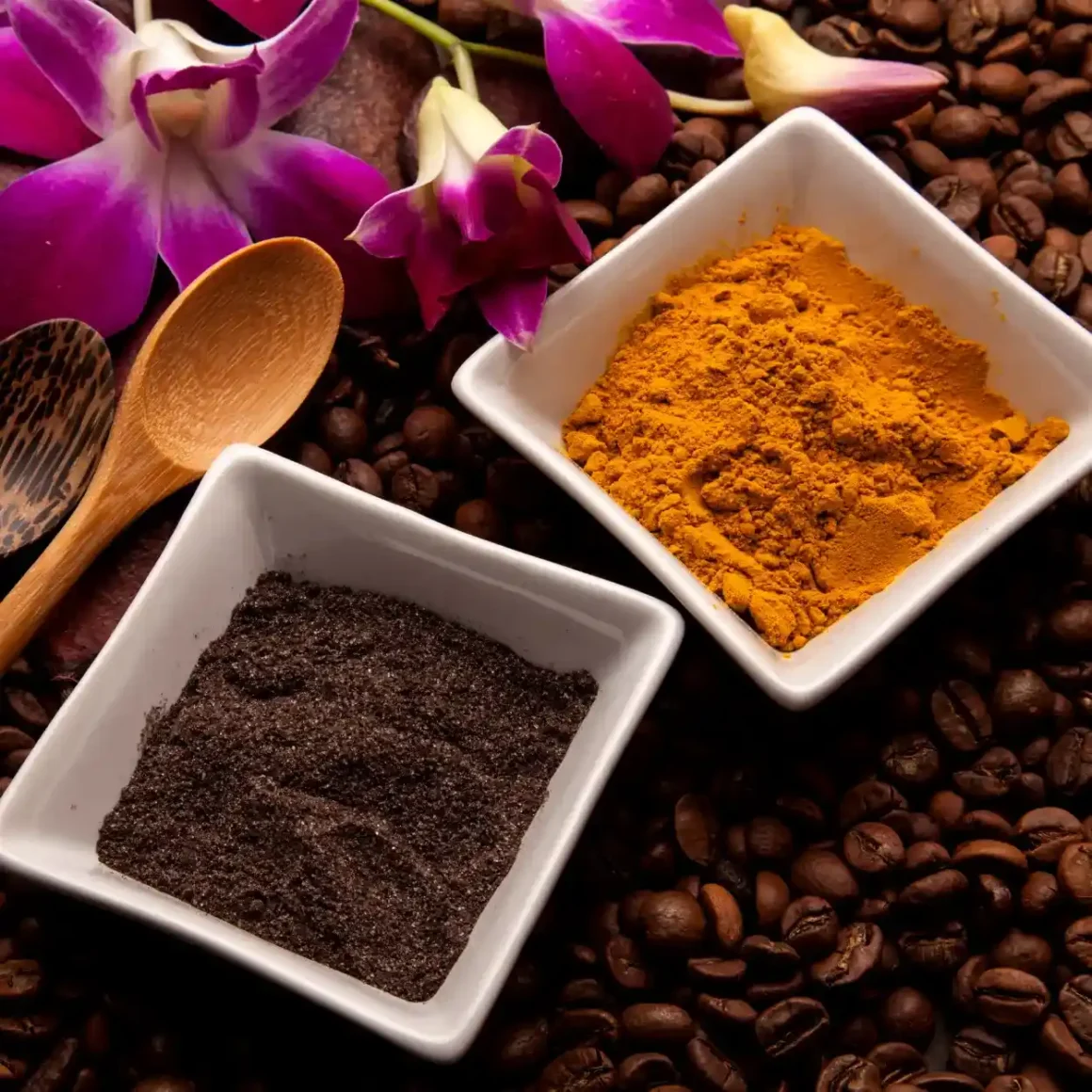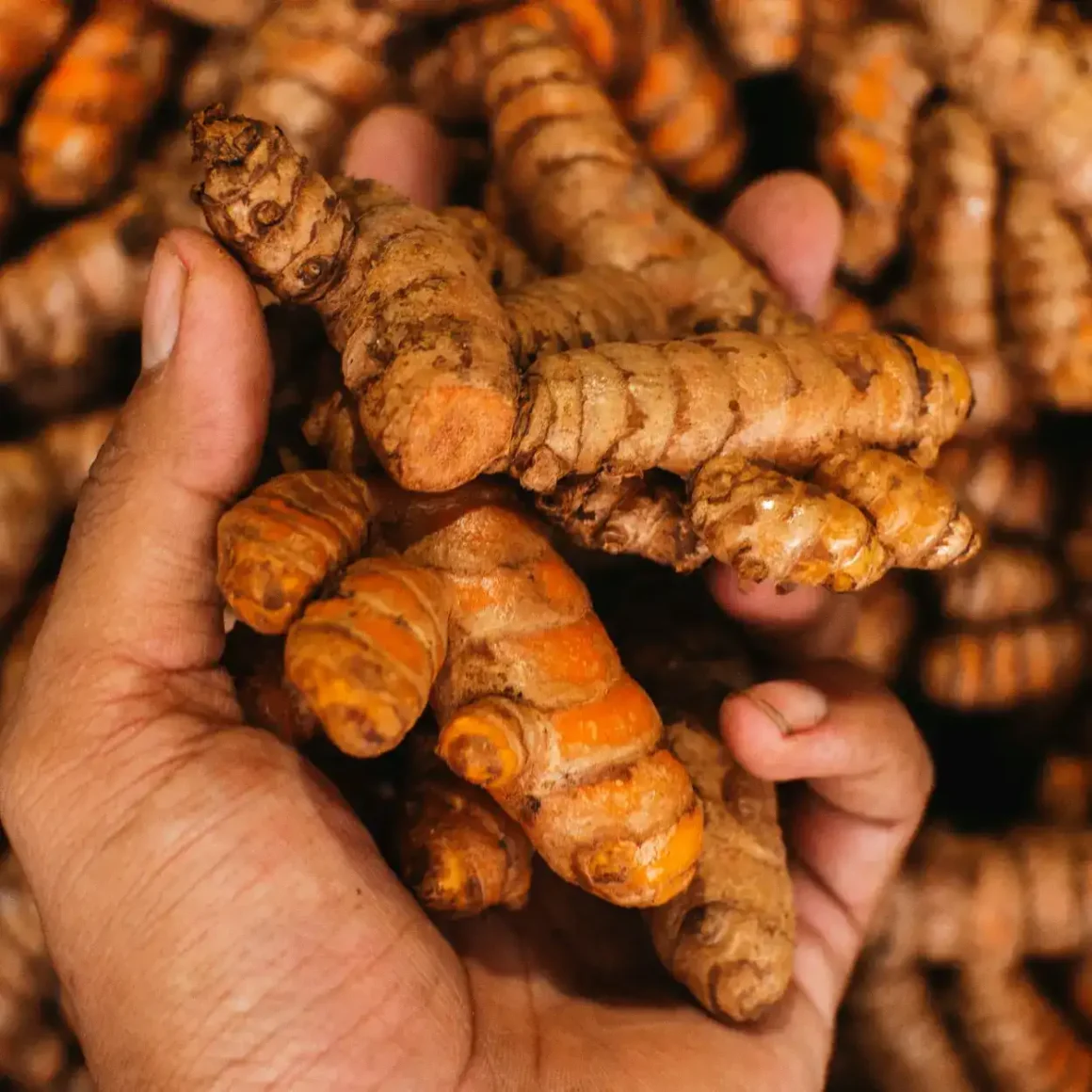The inclusion of turmeric in coffee has emerged as a notable trend, marrying the rich, aromatic cup of joe with the ancient, healing spice known as turmeric. This guide aims to explore the multifaceted benefits of this combination and provide insights into the best practices for preparing it. Turmeric, known for its vibrant color and a host of health benefits, has found its way into the daily routines of health-conscious individuals and coffee enthusiasts alike. This article delves into the origins of this spice, its role across various cultures, and how it has been creatively blended into coffee traditions around the globe. As we journey through the art and science of combining this spice with coffee, we’ll uncover the nuances of taste, health benefits, and preparation methods that make this fusion not just a culinary trend, but a holistic experience. Whether you are a seasoned coffee aficionado or someone curious about this golden spice, this guide will provide you with comprehensive knowledge and practical tips to enhance your coffee experience with the goodness of this spice.
The Benefits of Adding Turmeric to Your Coffee

Incorporating turmeric into your daily coffee ritual can significantly enhance your health and well-being. This combination not only creates a unique flavor profile but also imbues your cup of joe with a range of health benefits. Here, we delve into the specifics of how adding this spice to your coffee can be advantageous.
Anti-Inflammatory Properties

The addition of turmeric in coffee brings with it notable anti-inflammatory benefits.
- Natural Compound Curcumin: This spice is enriched with curcumin, a bioactive compound known for reducing inflammation. This is especially beneficial for those dealing with chronic inflammatory conditions. (1)
- Relief from Joint Pain: People suffering from joint pain, often caused by inflammation, may find relief through regular consumption of turmeric-laden coffee.
- Overall Inflammation Reduction: By consistently consuming this mixture, it’s possible to lower the body’s overall inflammation levels, which in turn can prevent a variety of related health issues and enhance overall health.
Potential Antioxidant Effects

Turmeric in coffee not only imparts a unique flavor but also provides potent antioxidant effects. These antioxidants play a crucial role in protecting the body against cellular damage.
- Combatting Free Radicals: This spice’s high antioxidant content is effective in fighting free radicals, which are unstable molecules that can cause oxidative stress and damage to cells.
- Preventing Cellular Damage: The antioxidants in turmeric help shield the body from the harmful effects of these free radicals, thereby preventing cellular damage and contributing to long-term health.
Enhanced Digestion Support

Incorporating turmeric in coffee can also be beneficial for digestive health. This spice is known for its ability to support healthy digestion, making it a valuable addition to your morning routine.
- Stimulating the Gallbladder: This spice stimulates the gallbladder to produce bile, which is essential for the digestion and absorption of fats.
- Soothing the Digestive Tract: It can also help in soothing the digestive tract, reducing symptoms like bloating and gas. (2)
- Promoting Gut Health: The anti-inflammatory and antioxidant properties of this spice also contribute to overall gut health, which is crucial for effective digestion and absorption of nutrients.
By incorporating this spice into your coffee, you’re not just enhancing its flavor, but you’re also imbuing it with a range of health benefits that contribute to overall wellness. The turmeric in coffee benefits encompass anti-inflammatory effects, antioxidant protection, and support for digestion, making it a worthwhile addition to your daily routine.
Potential Risks and Considerations
While exploring the question of whether can you put turmeric in coffee, it’s essential also to consider the potential risks and factors that might influence this practice. Understanding these aspects is crucial to ensure that you can enjoy the benefits of turmeric in your coffee while being aware of any possible downsides.
Turmeric Side Effects

Turmeric, while widely recognized for its numerous health benefits, is not without its potential risks and considerations.
- Digestive Upset: This spice, while known for its digestive health benefits, can cause digestive discomfort when consumed in excess. It increases stomach acid production, which can be beneficial for some but unpleasant to others. (3)
- Dosage Considerations: It’s important to consider the quantity of the spice added to coffee. Excessive amounts might not only overpower the coffee’s flavor but could also lead to unanticipated health issues due to low absorption.
- Blood Thinning: This spice’s cleansing properties may lead to blood-thinning effects, increasing the risk of bleeding. While the exact mechanism is not fully understood, this may explain some of its reported benefits like lowered cholesterol and blood pressure.
Taste and Palatability

The addition of turmeric in coffee can significantly alter its taste and palatability, which might not be agreeable to everyone.
- Distinct Flavor: This spice has a strong, earthy flavor that can overpower the coffee’s natural taste. This might be unappealing to traditional coffee lovers.
- Experimentation with Proportions: Finding the right balance is key. Start with a small amount of this spice and adjust according to your taste preferences.
- Combining with Other Spices: To improve palatability, consider pairing turmeric with other complementary spices like cinnamon or ginger, which can balance and enhance the overall flavor profile.
Allergic Reactions and Side Effects

While this spice is generally safe, it’s important to be mindful of potential allergic reactions and side effects, especially when consumed in large quantities.
- Allergic Reactions: Some individuals may be allergic to this spice, which could lead to symptoms like rashes, hives, or gastrointestinal distress.
- Interactions with Medications: This spice can interact with certain medications, including blood thinners and diabetes drugs. Consult with a healthcare provider if you’re on medication.
- Gastrointestinal Discomfort: In some cases, excessive consumption of turmeric can cause gastrointestinal issues like indigestion, nausea, or diarrhea.
To sum up, while adding turmeric in coffee can offer health benefits, it’s important to consider factors like turmeric side effects, taste alterations, and potential allergic reactions. Moderation and careful experimentation are key to enjoying this unique combination without undesirable effects.
Making the Perfect Cup of Turmeric Coffee
Creating the perfect cup of turmeric coffee involves a delicate balance of ingredients and careful preparation. This unique beverage blends the robust flavors of coffee with the earthy notes of this spice, offering a delicious and healthful drink. Let’s explore the essentials for crafting this delightful coffee.
Ingredients You’ll Need

To begin, gather the following ingredients to ensure your turmeric coffee is both flavorful and beneficial:
- Coffee: Start with your choice of coffee, whether it’s a freshly brewed espresso or a regular drip coffee. The quality of the coffee plays a significant role in the final taste.
- Turmeric Powder: This is the key ingredient. Ensure that the turmeric powder is fresh and of good quality for the best flavor and health benefits.
- Milk or Milk Alternative: Depending on your preference, select a milk or a plant-based alternative. This adds creaminess to the coffee.
- Sweetener (Optional): You can add honey, sugar, or a sugar substitute if you prefer a sweeter drink.
- Additional Spices (Optional): Consider cinnamon, ginger, or black pepper. Black pepper, in particular, can enhance the absorption of curcumin from turmeric.
Step-by-Step Preparation

Follow these steps to prepare your turmeric coffee:
- Brew Your Coffee: Start by brewing your coffee as you normally would. This can be through a coffee machine, a French press, or any other method you prefer.
- Add Turmeric: Once the coffee is brewed, stir in a quarter to a half teaspoon of this spice powder. Adjust according to your taste preference.
- Warm the Milk: If you’re using milk or a milk alternative, heat it until it’s warm but not boiling.
- Combine Ingredients: Add the warm milk to your coffee and turmeric mixture. Stir well to ensure everything is evenly combined.
- Sweeten and Spice: If desired, add your sweetener and any additional spices at this stage, and give it another good stir.
- Serve Immediately: Enjoy your cup of joe while it’s warm for the best experience.
Creative Variations to Try

Once you’re comfortable with the basic recipe, experiment with these creative variations:
- Iced Turmeric Coffee: For a refreshing twist, let your turmeric coffee cool down and then pour it over ice. This is perfect for warmer weather.
- Turmeric Coffee Latte: Use a milk frother to create a frothy top for your coffee, giving you a latte-like experience.
- Spiced Turmeric Coffee: Add spices like cinnamon or nutmeg for additional flavor complexity. This works especially well during the colder months.
- Vegan Turmeric Coffee: Use almond, soy, or oat milk as a dairy-free alternative. These plant-based milks also add their unique flavors to the coffee.
Incorporating turmeric in coffee can be a delightful and healthful experience. By starting with the right ingredients, following the simple preparation steps, and experimenting with various creative variations, you can enjoy the perfect cup of turmeric coffee tailored to your taste.
Turmeric Powder vs. Turmeric Extract

When considering the inclusion of turmeric in coffee, it’s important to understand the differences between turmeric powder and turmeric extract. Both forms offer their unique benefits and characteristics, impacting how they can be best used in your coffee.
Turmeric Powder:
Turmeric powder is the most common form used in culinary applications, including its use in coffee. Here are some key points to consider:
- Made from Ground Turmeric Root: Turmeric powder is made by drying and grinding the turmeric root. This process retains most of the natural compounds found in the root.
- Flavor Profile: It has a warm, bitter, and earthy flavor, which can significantly alter the taste of your coffee. Its intensity depends on the quantity used.
- Curcumin Content: While this powder contains curcumin, the concentration is relatively low compared to extracts. This means a larger quantity may be needed to achieve the desired health benefits.
- Culinary Versatility: Its powder form makes it easy to blend with other ingredients, making it a popular choice for adding to coffee, as well as various dishes and beverages.
Turmeric Extract:
Turmeric extract, on the other hand, is a more concentrated form, typically used for its health benefits. Here are some aspects to consider:
- High Curcumin Concentration: Extracts are made by isolating curcumin and other active compounds from the turmeric root, resulting in a higher concentration of these beneficial elements.
- Usage for Health Benefits: Due to its high curcumin content, this extract is often used in supplements and for therapeutic purposes.
- Less Impact on Flavor: Since the extract is more concentrated, a smaller quantity is required, which may have a less pronounced effect on the taste of your coffee compared to the powder.
- Solubility Considerations: This extract may vary in its solubility in liquids, so it’s important to ensure that it blends well into your coffee without leaving residue.
In summary, when adding this spice to coffee, the choice between the powder and the extract version depends on your flavor preferences and health objectives. The powder offers a distinct flavor and is versatile in culinary uses, whereas the extract version provides a concentrated dose of beneficial compounds with less impact on the taste of your coffee. Both forms can be beneficial, but it’s important to consider the differences to optimize your turmeric in cup of joe experience.
Turmeric Coffee vs. Traditional Coffee

The addition of this spice to coffee creates a unique beverage that stands out from traditional coffee. This fusion brings a distinct flavor profile, alters the caffeine content slightly, and requires consideration when choosing the right blend. Let’s delve into these aspects to better understand what does turmeric taste like in coffee and how it differs from your regular cup of joe.
Flavor Comparison
The most notable difference between turmeric coffee and traditional coffee is the flavor.
Turmeric Coffee:
- Earthy and Spicy: This spice adds an earthy, slightly spicy, and warm flavor to the coffee. This can be a pleasant surprise for those accustomed to the straightforward bitterness of traditional coffee.
- Balancing the Flavors: The key is to balance the strong flavor of this spice with the coffee’s natural taste. This might require some experimentation to find the perfect ratio.
- Additional Spices: Often, turmeric coffee is accompanied by other spices like cinnamon or ginger, which complement and enhance the overall flavor profile.
Traditional Coffee:
- Rich and Pure Coffee Flavor: Traditional coffee is all about the beans’ flavor, which can range from bitter and robust to smooth and mild, depending on the roast and origin.
- No Competing Flavors: Unlike turmeric coffee, traditional coffee doesn’t have the additional layer of spice, allowing the pure coffee flavor to shine through.
Caffeine Content
The caffeine content in both turmeric coffee and traditional coffee can vary, but there are some general points to consider.
Turmeric Coffee:
- Slightly Diluted Caffeine: The addition of turmeric and other spices may slightly dilute the caffeine concentration, depending on the proportions used. However, this difference is generally minimal.
- Impact of Added Ingredients: The overall caffeine content can also be influenced by additional ingredients like milk or sweeteners, which don’t alter the caffeine but may affect the perception of its strength.
Traditional Coffee:
- Consistent Caffeine Levels: Traditional coffee typically offers a consistent caffeine level, ranging from 80 to 100 mg. This is primarily determined by the type of coffee bean and brewing method.
- Predictable Effects: Regular coffee drinkers often rely on this consistency for their desired caffeine effects, such as energy boosts or focus enhancement.
Choosing the Right Blend
Selecting the right coffee blend is crucial for both forms of coffee but for different reasons.
Turmeric Coffee:
- Complementary Coffee Types: When adding this spice, opt for coffee blends that can harmonize with its robust flavor. Medium to dark roasts often work well.
- Experimentation: It may take a few tries to find the perfect coffee that balances well with turmeric’s distinct taste.
Traditional Coffee:
- Preference-Based Selection: With traditional coffee, the choice often comes down to personal preference regarding flavor intensity, acidity, and body.
- Wide Range of Options: From light to dark roasts and single-origin to blends, traditional coffee offers a wide array of choices to suit different palates.
In summary, turmeric coffee offers a unique twist on the classic beverage, introducing an earthy and slightly spicy flavor profile, with a minimal impact on caffeine content. Choosing the right blend is key in both cases, with this concoction requiring a bit more experimentation to achieve the perfect balance. Whether you opt for the adventurous turmeric-infused version or stick with traditional coffee, each has its unique appeal and place in the coffee community.
The History and Cultural Significance
Turmeric, a vibrant yellow spice, has a rich history and holds significant cultural value in various parts of the world. Its usage extends beyond culinary applications, permeating cultural rituals, medicinal practices, and even religious ceremonies. In recent times, the introduction of turmeric into coffee has given rise to a new dimension of its cultural significance.
Origins of Turmeric

Tracing the roots of turmeric reveals a journey that spans several continents and centuries.
- Ancient Spice: This spice is believed to have originated in South Asia, particularly in the regions of modern-day India and Nepal. Historical records suggest its use dating back nearly 4000 years. (4)
- Traditional Medicine: It has been a staple in Ayurvedic medicine, an ancient Indian healing system, for its anti-inflammatory and healing properties.
- Spread Across Continents: Over the centuries, this spice spread to other parts of Asia, Africa, and the Caribbean, mainly through spice trade routes.
Turmeric’s Role in Different Cultures

The cultural significance of this spice is as diverse as its uses.
- Culinary Uses: In South Asian and Middle Eastern cuisines, this spice is a key ingredient, valued for its flavor and coloring properties.
- Religious and Ceremonial Use: In Hindu and Buddhist traditions, turmeric holds religious significance, used in ceremonies and rituals, symbolizing purity, fertility, and prosperity.
- Medicinal Applications: Beyond cuisine, its medicinal properties are recognized in various traditional healing practices worldwide, from Ayurveda in India to Chinese traditional medicine.
Turmeric Coffee Around the World

The fusion of turmeric with coffee is a relatively recent trend that has gained popularity globally.
- Western Adaptation: In Western countries, turmeric coffee, often referred to as “turmeric latte” or “golden milk,” has become a popular alternative to traditional coffee, especially among health-conscious consumers.
- Global Variations: Different cultures have adopted this trend, adding their unique twists, such as incorporating local spices or using specific coffee brewing methods.
- Health and Wellness Trend: The blend of this spice and coffee is often marketed for its potential health benefits, aligning with the global trend towards health and wellness.
Overall, turmeric’s journey from an ancient spice to a globally recognized ingredient reflects its versatility and enduring appeal. Its integration into coffee culture is just the latest chapter in its long history, highlighting its continuous evolution and adaptation across different cultures and cuisines.
Conclusion
In conclusion, the fusion of turmeric in coffee blends tradition with modern wellness, offering a unique and healthful twist to the beloved beverage. This fusion not only enhances the flavor profile of coffee but also brings significant health benefits, such as anti-inflammatory and antioxidant properties. The versatility of this spice, whether in powder or extract form, allows for creative and personalized coffee experiences. As this trend continues to gain popularity worldwide, it stands as a testament to the evolving landscape of culinary wellness and the enduring appeal of combining good taste with health benefits.
FAQ
What are the potential side effects of consuming turmeric in coffee?
Potential side effects of consuming this spice in coffee include digestive discomfort, allergic reactions, and interactions with certain medications, particularly blood thinners.
Can turmeric coffee help with weight management?
This beverage might aid in weight management due to the spice's potential to enhance metabolism and fat digestion, although its effectiveness varies from person to person.
How does turmeric affect the taste of coffee?
This spice adds an earthy, slightly spicy flavor to coffee, altering its traditional taste profile.
Are there any contraindications for combining turmeric and coffee?
Yes, contraindications include individual allergies to this spice and potential adverse interactions with certain medications, especially blood thinners and diabetes medications.













